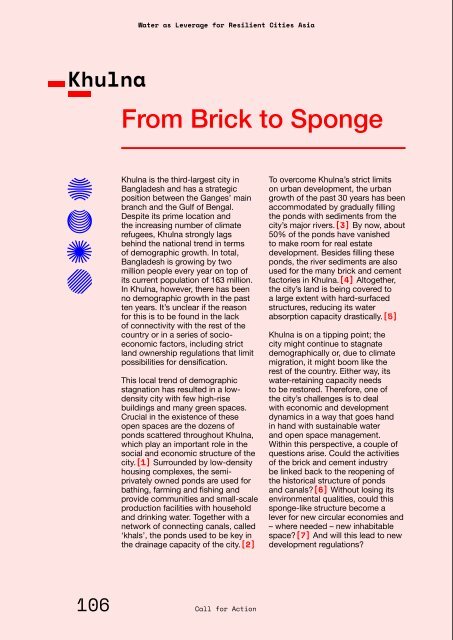Water as Leverage- Setting the scene for a call for action
- No tags were found...
Create successful ePaper yourself
Turn your PDF publications into a flip-book with our unique Google optimized e-Paper software.
<strong>Water</strong> <strong>as</strong> <strong>Leverage</strong> <strong>for</strong> Resilient Cities Asia<br />
Khulna<br />
From Brick to Sponge<br />
Khulna is <strong>the</strong> third-largest city in<br />
Bangladesh and h<strong>as</strong> a strategic<br />
position between <strong>the</strong> Ganges’ main<br />
branch and <strong>the</strong> Gulf of Bengal.<br />
Despite its prime location and<br />
<strong>the</strong> incre<strong>as</strong>ing number of climate<br />
refugees, Khulna strongly lags<br />
behind <strong>the</strong> national trend in terms<br />
of demographic growth. In total,<br />
Bangladesh is growing by two<br />
million people every year on top of<br />
its current population of 163 million.<br />
In Khulna, however, <strong>the</strong>re h<strong>as</strong> been<br />
no demographic growth in <strong>the</strong> p<strong>as</strong>t<br />
ten years. It’s unclear if <strong>the</strong> re<strong>as</strong>on<br />
<strong>for</strong> this is to be found in <strong>the</strong> lack<br />
of connectivity with <strong>the</strong> rest of <strong>the</strong><br />
country or in a series of socioeconomic<br />
factors, including strict<br />
land ownership regulations that limit<br />
possibilities <strong>for</strong> densification.<br />
This local trend of demographic<br />
stagnation h<strong>as</strong> resulted in a lowdensity<br />
city with few high-rise<br />
buildings and many green spaces.<br />
Crucial in <strong>the</strong> existence of <strong>the</strong>se<br />
open spaces are <strong>the</strong> dozens of<br />
ponds scattered throughout Khulna,<br />
which play an important role in <strong>the</strong><br />
social and economic structure of <strong>the</strong><br />
city.[1] Surrounded by low-density<br />
housing complexes, <strong>the</strong> semiprivately<br />
owned ponds are used <strong>for</strong><br />
bathing, farming and fishing and<br />
provide communities and small-scale<br />
production facilities with household<br />
and drinking water. Toge<strong>the</strong>r with a<br />
network of connecting canals, <strong>call</strong>ed<br />
‘khals’, <strong>the</strong> ponds used to be key in<br />
<strong>the</strong> drainage capacity of <strong>the</strong> city.[2]<br />
To overcome Khulna’s strict limits<br />
on urban development, <strong>the</strong> urban<br />
growth of <strong>the</strong> p<strong>as</strong>t 30 years h<strong>as</strong> been<br />
accommodated by gradually filling<br />
<strong>the</strong> ponds with sediments from <strong>the</strong><br />
city’s major rivers.[3] By now, about<br />
50% of <strong>the</strong> ponds have vanished<br />
to make room <strong>for</strong> real estate<br />
development. Besides filling <strong>the</strong>se<br />
ponds, <strong>the</strong> river sediments are also<br />
used <strong>for</strong> <strong>the</strong> many brick and cement<br />
factories in Khulna.[4] Altoge<strong>the</strong>r,<br />
<strong>the</strong> city’s land is being covered to<br />
a large extent with hard-surfaced<br />
structures, reducing its water<br />
absorption capacity dr<strong>as</strong>ti<strong>call</strong>y.[5]<br />
Khulna is on a tipping point; <strong>the</strong><br />
city might continue to stagnate<br />
demographi<strong>call</strong>y or, due to climate<br />
migration, it might boom like <strong>the</strong><br />
rest of <strong>the</strong> country. Ei<strong>the</strong>r way, its<br />
water-retaining capacity needs<br />
to be restored. There<strong>for</strong>e, one of<br />
<strong>the</strong> city’s challenges is to deal<br />
with economic and development<br />
dynamics in a way that goes hand<br />
in hand with sustainable water<br />
and open space management.<br />
Within this perspective, a couple of<br />
questions arise. Could <strong>the</strong> activities<br />
of <strong>the</strong> brick and cement industry<br />
be linked back to <strong>the</strong> reopening of<br />
<strong>the</strong> historical structure of ponds<br />
and canals?[6] Without losing its<br />
environmental qualities, could this<br />
sponge-like structure become a<br />
lever <strong>for</strong> new circular economies and<br />
– where needed – new inhabitable<br />
space?[7] And will this lead to new<br />
development regulations?<br />
[7]<br />
?<br />
[2]<br />
[1]<br />
[5]<br />
[6]<br />
[3]<br />
[4]<br />
106 Call <strong>for</strong> Action<br />
PART 1 / From Global <strong>Water</strong> Issues to a Call <strong>for</strong> Action<br />
?<br />
?<br />
107


















